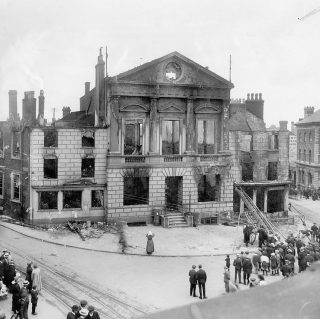Artist Scott King has been commissioned to produce two artworks for ‘As You Change, So Do I’.
Keep the Home Fires Burning
For ‘As You Change, So Do I’, artist Scott King will produce Keep the Home Fires Burning, an event that will include performances by a lone violinist and local Bedfordshire musicians at central Luton railway station during the morning and evening rush hours on 29 September to send off and subsequently welcome back commuters to London. Importantly, the artist will work alongside the renowned filmmaker Paul Kelly to create a document of the town’s commuter population on this day that will result in a short, three-minute film that will operate in much the same way as a pop video.
As a celebration of Luton’s working community, the project aims to comment on Luton’s current sacrificial economic relationship with London, alongside a constellation of other facts that reveal the town’s connection with music and drama and the relationship between work, travel and politics. Historical moments range from the psychological effects of repetitious commuting to the emotive history of British soldiers being sent to fight in WW1, alongside the Situationist International’s ideas around freedom in the 1960s and its later effect on British punk in the 1970s (as a revolutionary political movement, one of the SI’s most famous slogans was Ne travaillez jamais, which translates to ‘never work’).

In keeping with King’s festival atmosphere, the project’s title is taken from the famous 1914 song Keep the Home Fires Burning written by Ivor Novello and Lena Guilbert Ford. This tune has accrued a specific link to the history of Luton: in 1918 de-mobbed soldiers ran amok in frustration at the actions of the town’s self-serving mayor and bureaucratic town council who had organised a bogus welcome-home parade that only included the great and the good of the local community. Their lack of acknowledgement of the sacrifice of working people and soldiers during WWI culminated in Luton’s original town hall on George Street being set alight and burned to the ground, during a riot that ironically became the soldiers own makeshift street party. This mini-festival was accompanied by Novello and Guilbert Ford’s song, played on a piano that had been dragged from a looted music shop.
In all, Keep the Home Fires Burning forms a tribute to this historical action from 98 years ago alongside Luton’s communities’ continued resilience in the face of contemporary economic pressures.
#homefiresburning










Mother and Child (Luton)
King will also involve local people to reconstruct Henry Moore’s famous series of sculptures Mother and Child, works that were made during the 1920s through to the 1960s, and which became a staple for civic public sculpture during the post-war era in the UK.
Titled Mother and Child (Luton), new images taken by photographer Aleksandra Warchol will result in a series of projected impressions of families from the local community, a selection of which will be shown in sequence between September and December 2016 on the Culture Wall on the corner of Bute Street and Guildford Street.
Combining a narrative from public sculpture and the history of art theory from Modernist critics such as Herbert Read to fashion, community engagement and a critique of regeneration, King provides an ambiguous comment on our myriad attempts to overcome inequalities against the odds, alongside the value of government funded contemporary art in the British regions.
How music translates into a visual object fascinates artist Scott King. Previously for SNAP, the annual arts festival in Aldeburgh in 2013, King produced a large outdoor billboard that combined the musical score of Playful Pizzicato from Benjamin Britten’s Simple Symphony and the Royal Bank of Scotland logo – both elements of an RBS television advert that aired several years ago. Their re-presentation through ‘high’ and ‘low’ forms translated the advert into a physical visual object, and provided a score from which a small live orchestra performed. This representation of music across contexts draws attention to how meaning is recuperated.
#motherandchild
About Scott King
Scott King was born in 1969 in Goole, East Yorkshire, England. He previously worked as Art Director of i-D and Creative Director of Sleazenation magazines. King has also designed record sleeves for the Pet Shop Boys, Suicide, Earl Brutus and Morrissey amongst many others, and in 2013 he finally made a record of his own entitled You’re My Favorite Artist (Vinyl Factory). For almost twenty years, King has created work under the banner CRASH! with historian Matthew Worley. King’s work has been exhibited internationally in both commercial galleries and institutions and he has produced several books, including Anxiety & Depression (2009), Art Works (2010) and Anish & Antony Take Afghanistan (2014), all with JRP|Ringier, and most recently Public Art (2016) with Slimvolume.



